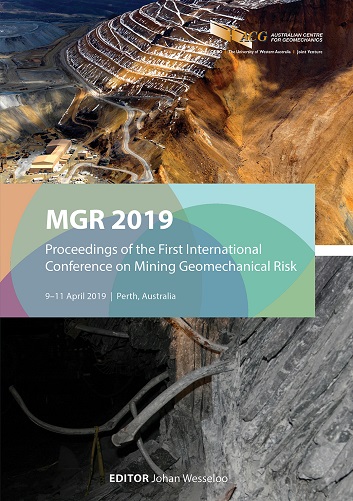A case study: managing decline deformation in an active sublevel caving operation

|
Authors: Woods, MJ; Fitch, S; Doolan, J; Barnett, DS |
DOI https://doi.org/10.36487/ACG_rep/1905_31_Woods
Cite As:
Woods, MJ, Fitch, S, Doolan, J & Barnett, DS 2019, 'A case study: managing decline deformation in an active sublevel caving operation', in J Wesseloo (ed.), MGR 2019: Proceedings of the First International Conference on Mining Geomechanical Risk, Australian Centre for Geomechanics, Perth, pp. 505-520, https://doi.org/10.36487/ACG_rep/1905_31_Woods
Abstract:
Telfer Gold Mine is located in the Great Sandy Desert and consists of both open pit and underground operations, including a mature sublevel cave (SLC). Changes to SLC design, with the addition of several sublevels, have resulted in an increased cave influence zone, with particular impact on the 4650 to 4600 Decline. This increased cave influence was identified during the planning stage risk assessment for the additional sublevels and a monitoring plan with associated trigger action response plans (TARPs) were included in the cave major hazard management plan (CMHMP). Once TARPs were triggered, ground support upgrades and a planned bypass were initiated for a section of the main decline. High underground temperatures and difficult work conditions resulted in the bypass activity being delayed until temperatures subsided. Due to the delays with bypass development and ongoing progression of deformation at a faster-than-expected rate, access through the original section of decline needed to be maintained for a greater length of time and with higher-than-expected deformation rates. Both a tactical ground support upgrade and a risk management plan based around monitoring data were used to maintain safe access through the main decline until the bypass was complete. Monitoring data showed a clear cause and effect between SLC production and deformation, allowing SLC production holds to be used as a key control.
Keywords: risk management, deformation, monitoring, mine planning
References:
Beck, DA & Sandy, MP 2003, ‘Mine sequencing for high recovery in Western Australian mines’, AusIMM Bulletin, May/June, no. 3.
pp. 145–155.
Kaiser, PK, Tannant, DD, McCreath, DR & Jesenak, P 1992, ‘Rockburst damage assessment procedure’, in PK Kaiser & D McCreath (eds), Rock Support in Underground Mining and Construction, A.A. Balkema, Rotterdam, pp. 639–647.
Woods, MJ, Poulter, ME & King, RG 2018, ‘Progression and management of seismic hazard through the life of Telfer SLC’, in Y Potvin & J Jakubec (eds), Proceedings of the Fourth International Symposium on Block and Sublevel Caving, Australian Centre for Geomechanics, Perth, pp. 623–636.
© Copyright 2025, Australian Centre for Geomechanics (ACG), The University of Western Australia. All rights reserved.
View copyright/legal information
Please direct any queries or error reports to repository-acg@uwa.edu.au
View copyright/legal information
Please direct any queries or error reports to repository-acg@uwa.edu.au
